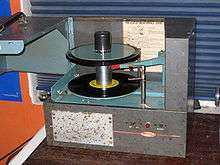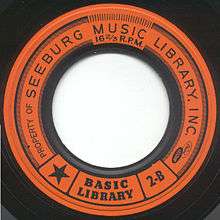Seeburg 1000
The Seeburg 1000 Background Music System is a phonograph designed and built by the Seeburg Corporation to play background music from special 16 2⁄3 RPM vinyl records in offices, restaurants, retail businesses, factories and similar locations. It provided a service similar to that of Muzak.

Phonograph
The Seeburg 1000 phonograph was introduced in 1959 as model BMS1.[1] The system replaced the Seeburg Library Unit, which served the same purpose but played standard 45 rpm records. The Seeburg 1000 is enclosed in a metal cabinet 22 inches (55 cm) wide by 14 inches (35 cm) tall by 12 inches (30 cm) deep.[2] A later version (the Seeburg Background Music Compact, model BMC1) is housed in a windowless, blue- and grey-painted metal box. This version contains only the record-playing mechanism, without any amplifier or timer built in.[3]
The player is capable of playing both sides of up to 28 records and repeating the process indefinitely. The records are stacked on the spindle with the first side to be played on the bottom of the stack. A special tone arm, with two needles (one above and one below), is used to play both sides of each record. A rotating base plate below the records prevents damage to the bottom playing surface while re-stacking the records. A similar weight on top of the stack ensures stable playback of the bottom side of the topmost record.
The mechanism causes the lower portion of the spindle to rotate clockwise like an ordinary record player, while the top half of the spindle rotates counterclockwise to permit the bottom of the record to be played in the correct direction. The spindle contains three sets of retractable claws which hold the records in the upper and lower playing positions, and permit one record at a time to be dropped from the upper to the lower playing position. A release button in the top of the spindle permits the operator to retract the record-holding claws to remove the record stack.
The BMS 1000 was so called because it played both sides of 25 records, each side containing 20 songs (hence 1,000 songs). The phonographs used the old Pickering "Red-head" stereo cartridge, introduced on Seeburg jukeboxes in late 1958 for the 1959 model year. Although the mono Seeburg jukeboxes used 1 mil styluses and the stereo Seeburgs used .7 mil styluses, the background-music systems used a .5 mil stylus, but played the special mono records. The BMS phonographs were non-selectable and only played these proprietary formatted 9" records with 2" center holes - sequentially, and at 16 2⁄3rpm.
In 1963, Seeburg introduced the next generation BMS, the BMS2.[4] This phonograph has been nicknamed "the Microwave" in recent years due to its resemblance to the kitchen appliance, and was made for the public view. There was a lighted window where one could see the records playing, and the chrome speaker grille and trim made the little phonograph noteworthy. These BMS2s were also the first Seeburgs to use transistorized amplifiers, since Seeburg was still using tube (or valve) amplifiers in their full-size jukeboxes.
BMS phonographs lacking a power amplifier or internal speaker could have an optional preamplifier. Early preamps were tube-(valve-) type and (after 1963) transistorized. In 1963 the Seeburg BMCA1 "Companion Audio" speaker/4-watt amp unit became available, using both tubes and transistors. If more power or an amp was needed Seeburg had the HFA4-56, 60-watt tube (valve) amp available.
Records

A Seeburg Background Music record is a vinyl record of a non-standard 9 inch (23 cm)-diameter size with a 2 inch (5 cm) center hole. The recording is monaural, with a playing speed of 16⅔ rpm and a density of 420 grooves per inch.[2] A 0.5 mil diamond stylus is used for reproduction. Each side contains approximately 40 minutes of music (typically 20 songs). Records in each series were numbered 1-28 or 101-128; however, these numbers meant nothing other than where a record belonged in the stack.
The records were distributed four times a year, in boxes of seven. The operator was supposed to replace records in the system with new records of the same number (e.g. MM-125). Each box was labeled with the library type, date to place in service, and instructions for the operator (including that each record was to be returned to Seeburg after use). Upon return, the records were destroyed. A Basic library box from 1971 states that the records are the property of "Seeburg Music Library, Inc., 1510 N. Dayton St, Chicago 22, Ill".
Music

Seeburg provided three different libraries of music for use with the Seeburg 1000 system: Basic, Mood and Industrial. These library names were changed to Lifestyle, Penthouse, and Upbeat in 1979. The Basic library consisted of mid-tempo music selected from top 40 hits, show tunes and standards. The arrangements (created for Seeburg) were nearly all instrumental, featuring horns, strings and keyboards. The Mood library consisted of medium- to slow-tempo songs in lush arrangements (with primarily stringed instruments). The music was derived from standards, show tunes and some pop music; the first song on each side of each record was often a current pop hit. The Industrial library consisted of lively, medium- to quick-tempo music to induce workers to be more productive. This was perhaps the most varied and adventurous of the libraries; it contained polkas, mariachi music, twangy guitar, Hawaiian songs, and occasionally synthesizer.
A portion of the records were exchanged every three months: on April 1, July 1, October 1 and December 26. The number of records changed at each three-month interval was five in 1963,[5] and seven according to record boxes issued in 1966 and later. The first sets of Seeburg 16 rpm records issued in 1959 had a five-pointed star in the space later used for the "place-in-use" dates. This was superseded by a notice which read "Replace No. 1", "Replace No. 5" etc. This meant "Replacement Records - Set No. 1", "Set No. 5" etc. In 1961 this was again superseded by the "place in use" dates, which remained in use through the end of 1975. For the April 1, 1976 sets, the "place in use" dates were replaced by a code: RR-66. This meant "replacement records – set #66" and the number advanced with each subsequent set. Over time, the records were sent out less on a schedule. The last sets were sent out in 1986 and bore the code R-97.
The Christmas holiday season required a special set of records. A box of 25 Christmas records was issued to be played during the month of December. This set consisted of Christmas music, interspersed with non-holiday music. It was the job of the machine operators to replace all Christmas music with standard fare on December 26. This was a large undertaking - in New York, "the entire service and installation force, and even the office help, are pressed into service to still the sound of Christmas past for another 11 months."[5]
References
- ↑ Installation Manual, Seeburg '1000' Background Music System, Model BMS1
- 1 2 Biro, Nick (July 20, 1959). "Seeburg Background Music Move Part of Diversification Program". Billboard. New York. p. 67.
- ↑ Engineer's Manual, Seeburg '1000' Background Music Compact, Type BMC1
- ↑ source: Seeburg 1000 Service Manual, May 1963; and The Always Jukin' Color Guide To Collectible Jukeboxes, 2006
- 1 2 Kunis, Solomon (Dec 21, 1963). "Background Music Important Phase of Atlantic-N.Y. Operation". Billboard. New York. p. 44.
External links
- Live Streaming Background Music from the Seeburg 1000 Background Music System - The Official Page
- Live Seeburg 1000 Background Music System MP3 audio stream, from seeburg1000.com
- Video files of Seeburg 1000 equipment in operation
- The Official Seeburg 1000 Facebook Group Page
- The Official Seeburg 1000 Facebook Fan Page
- The Official Facebook Best of Seeburg 1000 Background Music Player
- The Official Seeburg 1000 Twitter Page
- Tony Miller's Seeburg BMS page